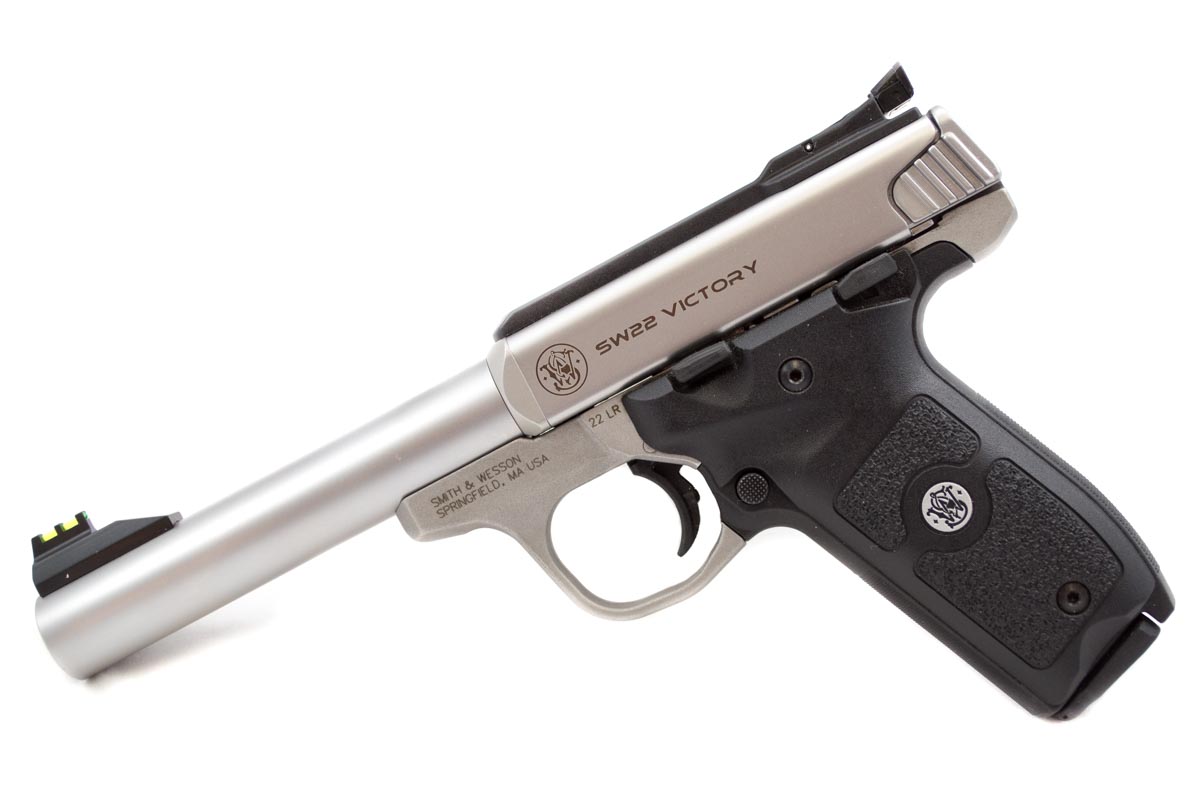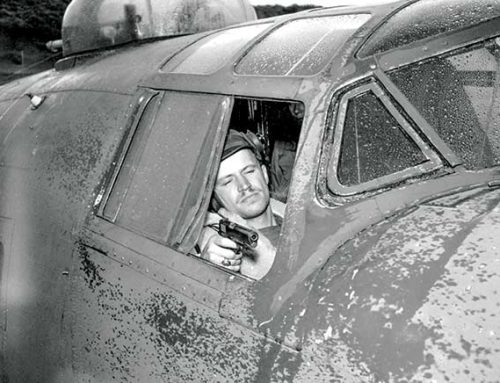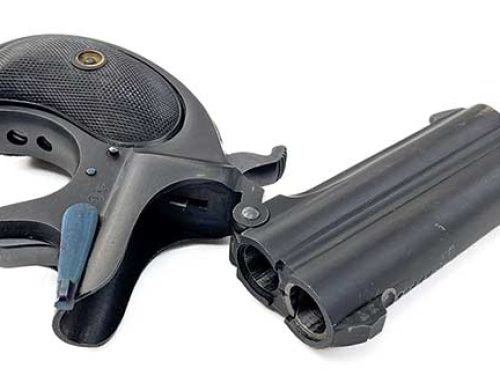This article originally appeared at GunsAmerica.

The Smith & Wesson Victory standard model.
Sometimes good things take time. Sometimes it’s a lot of time, but that’s OK if the end result is worth it.
I had the good fortune to visit the Smith & Wesson factory way back in November of 2014 to see a top secret new product. On a cold and icy morning, I sat in a classroom at the Smith & Wesson Training Academy along with a handful of other writers, anxiously awaiting the big news. To make a long story short, our Smith & Wesson hosts flashed up a picture of a new .22 LR pistol – the Victory. While I wouldn’t say the reaction was ho-hum, there was no standing ovation either.
But then something weird happened. Paul Pluff, VP of Marketing started to show us how to take it apart. While he was doing that, Scott Volquartsen of Volquartsen Custom started handing out some amazingly spiffy aftermarket barrels. While Scott had us distracted, our hosts from Blue Heron Communications started passing out an assortment of optics and holsters. By this time, we had stopped listening to the presentation completely and were each tearing apart our sample pistols like kids at a free XBox party. Paul kept talking, but I think he knew none of us were still listening.

Here’s the secret to easy takedown and parts changes.

All models include a 5.5-inch stainless, match grade barrel. It’ll shoot right out of the box.
You see, once we saw what the Victory was, we got it. The room full of industry old farts who have seen it all were positively giddy with this innovative rimfire pistol.
Why? The Victory is whatever you want it to be. It’s designed from the ground up to be stunningly accurate, yet modular. Imagine a pistol made of steel and aluminum Lego blocks that still shoots sub-inch groups until you get bored.
Want a new barrel? One screw pops the old one off and the new one on. How about swapping the adjustable rear sight for a rail? One screw. Field stripping for cleaning? Forget the frustrating parts disassembly and reassembly games of the Ruger .22 pistols. Like to shoot ultra quietly with a suppressor? It’s ready to go, depending on how you choose your base model or accessory barrels.

The Victory comes with a polymer rail so you can replace the adjustable rear sight base.

The receiver and rear sight are serrated to reduce glare.
This pistol is more like a dozen different handguns depending on how you put parts together. In short, it’s made in such a way as to encourage people like Scott Volquartsen to invent all sorts of aftermarket pieces and parts. The best part? The Victory has a starting MSRP of just $409, meaning you’ll pick them up for somewhere in the 300’s.
A Victory Tour
First of all, there are three base models from which you can start your personal .22 pistol project. All begin with the same basic frame and 5.5-inch stainless steel, match grade bull barrel. The differences in the three base models are primarily cosmetic. The standard Victory has a non-threaded barrel. There is also a threaded barrel model and a Kryptek® Highlander™ camo finished version. The core function features, with the exception of the threaded barrel, are the same between the three, so let’s take a closer look at the details present in all three.

The receiver is fixed in position while the bolt is charged from the back.

Note the overtravel adjustment screw in the trigger face.
The frame, bolt, and barrel are all stainless steel, but with slightly different finishes. The frame area around the trigger guard area has a fresh from the forge roughed up look, which is kind of cool. The receiver and barrel are a bead blasted matte stainless steel finish, which does a good job of reducing glare.
The receiver, bolt, and charging mechanism are similar to the Ruger 22/45 and Mark III series, with a fixed receiver and charging handle that one pulls to the rear. The feel is easy and silky smooth. No rough stuff in the bolt operation.

The polymer grip resembles that of the Model 22A.

The ejection port is generous and I had no function troubles testing over a dozen types of .22 LR ammo.
The trigger is excellent, with a short take-up and crisp break. The pull weight is right at three pounds as measured by my Timney Triggers scale. As a result of the light weight and crisp operation, you’ll shoot this gun accurately with ease. The flat face of the trigger is serrated vertically and has an overtravel adjustment screw set into the face.
The grip is made of polymer and will remind you of a Smith & Wesson Model 22A. The sides of the grip have a stippled pattern and the front and rear straps are patterned with fine checkering. Like many .22 target pistols, the grip angle is more severe than an M&P or 1911 style. A magazine release button is on the left side of the grip in the traditional spot behind the trigger.

The rear sight is adjustable and features a fiber optic tube.

Charging handle open.
The sights are excellent. The front is a green fiber optic tube mounted on a removable steel base, presumably to allow either removal if optics are used or to provide another opportunity for aftermarket customization. The rear sight is adjustable for both windage and elevation and features a U-shaped green fiber optic tube where the ends flank the square notch. The back of the rear sight and platform in front of the sight are grooved to reduce glare in the sight picture.
There is a frame mounted safety on the left side that pivots from the front. Flip the rear up to engage the safety and down to fire. It’s made of steel but wrapped in a polymer coating. It clicks on and off positively and has no mushiness whatsoever. I like it. About an inch forward of the safety is a slide lock lever, also polymer-wrapped steel.

The take-down screw is inset and stays out of the way of your firing hand.

The basic field stripped components.
The Victory models all include two 10-round magazines in the box. The bottom of the grip is cut to allow the shooter to pull the magazine out, although the steel magazines easily drop free on their own accord.
Lego time
OK, now let’s get to the fun part. Before I get into how you can reconfigure the Victory with aftermarket parts, let’s spend a minute on the takedown and field stripping process, because it’s brilliant.

Once field stripped, the barrel locking screw is exposed.

In this view, the bolt has been pulled out of the receiver.
There’s an Allen screw just forward of the trigger guard that locks the barrel and receiver to the frame. Loosen this, and the entire barrel and receiver lift off the frame in one piece. If you have optics mounted and zeroed, no worries, they remain untouched and unmoved from their mount. Once the barrel and receiver are removed, the bolt slides right out the back of the receiver. That’s it. If you want, you can drop the recoil spring out and clean to your hearts content. You can literally field strip and reassemble this gun blindfolded in seconds.
Now that you know how to separate the barrel and receiver from the frame, things start to get fun. The bottom of the receiver has another Allen screw that secures the barrel to the receiver. The screw just serves as a lock mechanism, all alignment and fit is accomplished by careful shaping of the barrel and receiver. They fit tightly together without the Allen screw in place. Again, removing the barrel from the receiver doesn’t interfere with any optics mounted, although if you install a different barrel, your point of impact will likely shift. If you remount the same barrel, the pistol maintains its existing point of aim and point of impact relationship. That was one of the first things I tried, just because I could.

Here, I’ve got the Volquartsen Carbon Fiber barrel installed.

It only takes seconds to swap the rear sight platform out for the included rail.
On top of the receiver, you’ll see the adjustable rear sight assembly This mounts to the frame with a wedge towards the rear and an Allen screw towards the front of the sight base. I mention this because in the box you’ll find a polymer rail segment that fits into this spot. Remove the rear sight assembly and mount the rail and you’re ready for optics. One super clever idea is that the rail has a notch sight in the back, so it serves as a rear “iron” sight too. If you don’t like the adjustable fiber optic rear sights, just replace that whole thing with the rail, and you have a plain black notch rear sight. It’s “oh duh” simple, but useful.
Do pay attention to instructions when reconfiguring because proper screw tension is important. If you under or over-tighten mounting screws, they can work loose. When properly tensioned, I’ve had no trouble with that however.

The Picatinny rail has a rear sight notch without the fiber optic tubes.

Here, I’ve got the Volquartsen fluted barrel installed with the rail segment up top.
Aftermarket toys
In the photos here, you’ll see some of the aftermarket goodies you can get for the Victory.
Barrels are a natural upgrade option due to the mounting design. I’ve got two different Volquartsen barrels that I’ve been testing. One is a 6.75-inch carbon fiber threaded barrel. The barrel itself is stainless steel, but the body is wrapped with black carbon fiber to reduce weight. It’s got a thread protector up front that serves to protect the muzzle just until you get your ATF tax stamp for a silencer. The second is an I-fluted bull barrel that measures six inches. Well, that’s just the actual bore length. The barrel has a matching blow compensator that adds an inch and a half to overall length. I say “matching” but the barrel and compensator really look like one solid piece of metal. When we got them at the sneak preview, most of assumed it was one solid piece of stainless steel with compensator ports machined in. That’s how precisely the Volquartsen folks fit these parts – they are literally seamless.

A couple of Victory-compatible Volquartsen barrels.

The Victory shown here with the Volquartsen I-Fluted barrel, Silencerco Sparrow suppressor and C-More RTS2 red dot sight.
The rear sight base and rail are also great candidates for aftermarket development. I’d bet a ham sandwich that the Volquartsen folks will produce a steel or aluminum rail before too long. I’d also expect one or more companies to crank out some beautiful wooden grips. Given the way front and rear sights are mounted, that’s another area where I anticipate seeing some interesting third party products.
Shooting for Victory
At the preview event, we were able to shoot these pistols immediately at the Smith & Wesson Training Academy. The giddiness continued. Every shooting bay had one of us with a pile of barrels, optics and ammo reconfiguring between every shot string. It was immediately apparent that the Victory is a shooter. The standard bull barrel has everything to be proud of, and as expected, the Volquartsen barrels performed even better.

For accuracy testing I mounted a Bushnell Elite 3500 handgun scope.

A sweet configuration. The lighter carbon fiber barrel helps offset the weight of the silencer.
Shortly after the event, the Smith & Wesson shipped out our evaluation units so we could do some extended testing back at home, so I’ve been able to shoot this pistol for over a year now. I’ve got quite a few .22 pistols, but this one has risen to the top of the favorite list. The feel is outstanding, and it points naturally for me. Add in a quality factory trigger and great accuracy and what’s not to like?

I tested accuracy with both the factory match barrel and the Volquartsen fluted barrel.

The safety and slide lock are steel wrapped with a polymer cover.
Speaking of accuracy, I tested a variety of .22 ammo over time, shooting multiple five-shot groups with each on different outings. I later averaged the various groups from each ammo type to see how the long-term average group size worked out. I did this using the standard factory 5.5-inch bull barrel and repeated the tests using the Volquartsen six-inch I-fluted barrel. While I was at it, I checked average velocity using a Shooting Chrony Beta Master Chronograph placed 15 feet down range. Here’s the summary.
| 5-Shot Group Size, 25 Yards, Factory 5.5-inch Barrel | Velocity (fps) | 5-Shot Group Size, 25 Yards, Volquartsen 6-inch Barrel | |
| Aguila Super Maximum | 2.43” | 1,381 | 0.89” |
| American Eagle HV Copper Plated | 0.76” | 1,052 | 0.9” |
| Armscor Precison Standard Velocity | 0.39” | 1,015 | 0.46” |
| CCI Green Tag | 0.62” | 907 | 0.79” |
| CCI Mini Mag HV | 0.86” | 1,032 | 0.94” |
| CCI Quiet-22 | 0.98” | 613 | 0.91” |
| CCI Stinger | 0.50” | 1,264 | 0.56” |
| Eley Practice 100 | 0.58” | 926 | 0.53” |
| Federal Target Grade | 1.13” | 1,075 | 1.28” |
| Remington 22 Golden Bullet | 0.91” | 1,038 | 0.85” |
| Remington 22 Thunderbolt | 1.42” | 959 | 1.34” |
| Winchester Match T22 LRN | 0.79” | 1,060 | 0.86” |
| Winchester Bulk Pack 555 HP | 0.77” | 1,123 | 1.05” |
As you can see, this pistol will shoot. Even the inexpensive bulk ammo turned in excellent accuracy results and when higher quality ammo turns in .50-inch (and less) average group size, that makes me happy.

The muzzle device on the Volquartsen fluted barrel.

Not too shabby for a 25-yard, five-shot group.
The Specs
SKU: 108490
Caliber: .22 LR
Capacity: 10+1 Rounds
Action: Single Action
Barrel Length: 5.5” (14.0 cm)
Weight: 36.0 oz. (1,020.6 g)
Overall Length: 9.2” (23.4 cm)
Overall Width: 1.1” (2.8 cm)
Overall Height: 5.6” (14.2 cm)
Frame Material: Stainless Steel
Bolt Material: Stainless Steel
Barrel Material: Stainless Steel
Finish: Satin Stainless
MSRP: $409

The Victory comes with two 10-round magazines.

I used the C-More RTS2 red dot sight. It’s a great fit for this pistol.
Closing thoughts
I absolutely love this gun. I test a lot of guns, and quite frankly, it’s rare to find one that I don’t enjoy or at least appreciate. It’s even more rare to find one that makes me smile every time I shoot it. The Victory is one of those guns. If you like effortless plinking, it’s highly recommended. Just beware that you’ll be customizing your Victory forever, but that’s most of the fun.








why no threaded barrel with a sight?
The factory threaded model does have a fiber optic sight just like the standard model. The Volquartsen barrels are intended for use with optics.